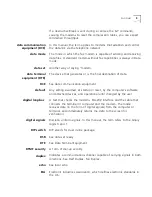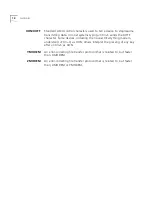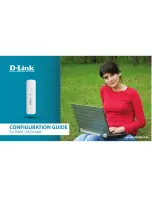
2
G
LOSSARY
dynamically reverse the channels during a call if the volume of data
transfer changes.
asynchronous
transmission
Data transmission in which the length of time between transmitte
characters may vary.
Because the time lapses between transmitted characters are not
uniform, the receiving modem must be signaled as to when the data
bits of a character begin and when they end. The addition of start an
stop bits to each character serves this purpose.
auto answer
A feature in modems enabling them to answer incoming calls over the
phone lines without the use of a telephone receiver.
auto dial
A feature in modems enabling them to dial phone numbers over the
phone system without the use of a telephone transmitter.
Automatic Repea
Request (ARQ)
A general term for error control protocols which feature error detectio
and automatic retransmission of defective blocks of data. See HST,
MNP, and V.42.
baud rat
The number of discrete signal events per second occurring on a
communications channel. Although not technically accurate, baud rate
is commonly used to mean bit rate.
binary digit (bit)
A 0 or 1, reflecting the use of a binary numbering system (only tw
digits). Used because the computer recognises either of two states, OFF
or ON. Shortened form of binary digit is bit.
BISYNC
Binary Synchronous Control. A protocol developed by IBM for software
applications and communicating devices operating in synchronous
environments. The protocol defines operations at the link level of
communications, for example, the format of data frames exchange
between modems over a phone line. See Protocol, HDLC, SDLC.
bit
See binary digit.
bit-mapping
A technique that lets one decimal number (in this case, a number
between 0 and 255) stand for up to 8 separate binary settings.
bit rat
The number of binary digits, or bits, transmitted per second (bps).
Communications channels using telephone channel modems are
established at set bit rates, commonly 300, 1200, 2400, 4800, 9600,
14400, and 28800.
Summary of Contents for Courier
Page 12: ......
Page 28: ...1 14 CHAPTER 1 CONNECTING TO YOUR ISP ...
Page 36: ...3 4 CHAPTER 3 UPGRADING YOUR MODEM ...
Page 58: ...6 6 CHAPTER 6 WORKING WITH MEMORY ...
Page 64: ...8 4 CHAPTER 8 CONTROLLING EIA 232 SIGNALING ...
Page 72: ...9 8 CHAPTER 9 ACCESSING AND CONFIGURING THE COURIER V EVERYTHING MODEM REMOTELY ...
Page 80: ...10 8 CHAPTER 10 CONTROLLING DATA RATES ...
Page 96: ...12 6 CHAPTER 12 FLOW CONTROL ...
Page 108: ...13 12 CHAPTER 13 HANDSHAKING ERROR CONTROL DATA COMPRESSION AND THROUGHPUT ...
Page 112: ...14 4 CHAPTER 14 DISPLAYING QUERYING AND HELP SCREENS ...
Page 122: ...15 10 CHAPTER 15 TESTING THE CONNECTION ...
Page 142: ...17 8 CHAPTER 17 TROUBLESHOOTING ...
Page 156: ...A 14 APPENDIX A S REGISTERS ...
Page 172: ...B 16 APPENDIX B ALPHABETIC COMMAND SUMMARY ...
Page 178: ...C 6 APPENDIX C FLOW CONTROL TEMPLATE ...
Page 186: ...E 4 APPENDIX E V 25 BIS REFERENCE ...













































